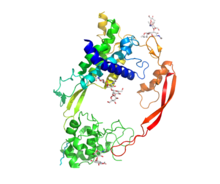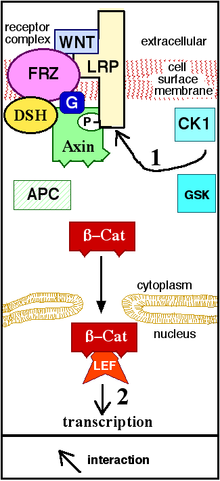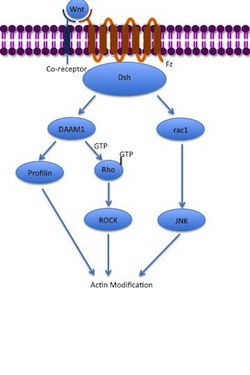Wnt signaling pathway
The Wnt signaling pathways are a group of
Three Wnt signaling pathways have been characterized: the canonical Wnt pathway, the noncanonical planar cell polarity pathway, and the noncanonical Wnt/calcium pathway. All three pathways are activated by the binding of a Wnt-protein
Wnt signaling was first identified for its role in
This pathway's clinical importance was demonstrated by
History and etymology
The discovery of Wnt signaling was influenced by research on
Int1 is highly conserved across multiple species, including humans and
Continued research led to the discovery of further int1-related genes; however, because those genes were not identified in the same manner as int1, the int gene
Proteins

Wnt comprises a diverse family of secreted
These proteins are highly conserved across species.[3] They can be found in mice, humans, Xenopus, zebrafish, Drosophila and many others.[17]
| Species | Wnt proteins |
|---|---|
Homo sapiens |
|
Mus musculus (Identical proteins as in H. sapiens) |
Wnt1, Wnt2, Wnt2B, Wnt3, Wnt3A, Wnt4, Wnt5A, Wnt5B, Wnt6, Wnt7A, Wnt7B, Wnt8A, Wnt8B, Wnt9A, Wnt9B, Wnt10A, Wnt10B, Wnt11, Wnt16 |
| Xenopus | Wnt1, Wnt2, Wnt2B, Wnt3, Wnt3A, Wnt4, Wnt5A, Wnt5B, Wnt7A, Wnt7B, Wnt8A, Wnt8B, Wnt10A, Wnt10B, Wnt11, Wnt11R |
Danio rerio |
Wnt1, Wnt2, Wnt2B, Wnt3, Wnt3A, Wnt4, Wnt5A, Wnt5B, Wnt6, Wnt7A, Wnt7B, Wnt8A, Wnt8B, Wnt10A, Wnt10B, Wnt11, Wnt16 |
| Drosophila | Wg, DWnt2, DWnt3/5, DWnt 4, DWnt6, WntD/DWnt8, DWnt10 |
| Hydra | hywnt1, hywnt5a, hywnt8, hywnt7, hywnt9/10a, hywnt9/10b, hywnt9/10c, hywnt11, hywnt16 |
| C. elegans | mom-2, lin-44, egl-20, cwn-1, cwn-2 [18] |
Mechanism


Foundation
Wnt signaling begins when a Wnt protein binds to the N-terminal extra-cellular cysteine-rich domain of a
Canonical and noncanonical pathways
The three best characterized Wnt signaling pathways are the canonical Wnt pathway, the noncanonical planar cell polarity pathway, and the noncanonical Wnt/calcium pathway. As their names suggest, these pathways belong to one of two categories: canonical or noncanonical. The difference between the categories is that a canonical pathway involves the protein

Canonical pathway
The canonical Wnt pathway (or Wnt/β-catenin pathway) is the Wnt pathway that causes an accumulation of

Noncanonical pathways
The noncanonical planar cell polarity (PCP) pathway does not involve β-catenin. It does not use LRP-5/6 as its co-receptor and is thought to use

The noncanonical Wnt/calcium pathway also does not involve β-catenin. Its role is to help regulate calcium release from the
Integrated Wnt Pathway
The binary distinction of canonical and non-canonical Wnt signaling pathways has come under scrutiny and an integrated, convergent Wnt pathway has been proposed.[36] Some evidence for this was found for one Wnt ligand (Wnt5A).[37] Evidence for a convergent Wnt signaling pathway that shows integrated activation of Wnt/Ca2+ and Wnt/β-catenin signaling, for multiple Wnt ligands, was described in mammalian cell lines.[38]
Other pathways
Wnt signaling also regulates a number of other signaling pathways that have not been as extensively elucidated. One such pathway includes the interaction between Wnt and GSK3. During cell growth, Wnt can inhibit GSK3 in order to activate
Regulation
In order to ensure proper functioning, Wnt signaling is constantly regulated at several points along its signaling pathways.
Upon secretion, the ligand can be prevented from reaching its receptor through the binding of proteins such as the stabilizers Dally and glypican 3 (GPC3), which inhibit diffusion. In cancer cells, both the heparan sulfate chains[42][43] and the core protein[44][45] of GPC3 are involved in regulating Wnt binding and activation for cell proliferation.[46][47] Wnt recognizes a heparan sulfate structure on GPC3, which contains IdoA2S and GlcNS6S, and the 3-O-sulfation in GlcNS6S3S enhances the binding of Wnt to the heparan sulfate glypican.[48] A cysteine-rich domain at the N-lobe of GPC3 has been identified to form a Wnt-binding hydrophobic groove including phenylalanine-41 that interacts with Wnt.[45][49] Blocking the Wnt binding domain using a nanobody called HN3 can inhibit Wnt activation.[45]
At the Fz receptor, the binding of proteins other than Wnt can antagonize signaling. Specific
Interactions between Wnt signaling pathways also regulate Wnt signaling. As previously mentioned, the Wnt/calcium pathway can inhibit TCF/β-catenin, preventing canonical Wnt pathway signaling.[7][24] Prostaglandin E2 (PGE2) is an essential activator of the canonical Wnt signaling pathway. Interaction of PGE2 with its receptors E2/E4 stabilizes β-catenin through cAMP/PKA mediated phosphorylation. The synthesis of PGE2 is necessary for Wnt signaling mediated processes such as tissue regeneration and control of stem cell population in zebrafish and mouse.[5] Intriguingly, the unstructured regions of several oversized intrinsically disordered proteins play crucial roles in regulating Wnt signaling.[52]
Induced cell responses
Embryonic development
Wnt signaling plays a critical role in embryonic development. It operates in both
Axis patterning
In early embryo development, the formation of the primary body axes is a crucial step in establishing the organism's overall body plan. The axes include the anteroposterior axis, dorsoventral axis, and right-left axis. Wnt signaling is implicated in the formation of the anteroposterior and dorsoventral (DV) axes. Wnt signaling activity in anterior-posterior development can be seen in mammals, fish and frogs. In mammals, the
Wnt signaling is also involved in the axis formation of specific body parts and organ systems later in development. In vertebrates,
In the embryonic differentiation waves model of development Wnt plays a critical role as part a signalling complex in competent cells ready to differentiate. Wnt reacts to the activity of the cytoskeleton, stabilizing the initial change created by a passing wave of contraction or expansion and simultaneously signals the nucleus through the use of its different signalling pathways as to which wave the individual cell has participated in. Wnt activity thereby amplifies mechanical signalling that occurs during development.[58][59]
Cell fate specification
Cell fate specification or cell differentiation is a process where undifferentiated cells can become a more specialized cell type. Wnt signaling induces differentiation of
Cell proliferation
In order to have the mass differentiation of cells needed to form the specified cell tissues of different organisms, proliferation and growth of
The biochemistry of cancer stem cells is subtly different from that of other tumor cells. These so-called Wnt-addicted cells hijack and depend on constant stimulation of the Wnt pathway to promote their uncontrolled growth, survival and migration. In cancer, Wnt signaling can become independent of regular stimuli, through mutations in downstream oncogenes and tumor suppressor genes that become permanently activated even though the normal receptor has not received a signal. β-catenin binds to transcription factors such as the protein TCF4 and in combination the molecules activate the necessary genes. LF3 strongly inhibits this binding in vitro, in cell lines and reduced tumor growth in mouse models. It prevented replication and reduced their ability to migrate, all without affecting healthy cells. No cancer stem cells remained after treatment. The discovery was the product of "rational drug design", involving AlphaScreens and ELISA technologies.[70]
Cell migration
Cell migration during embryonic development allows for the establishment of body axes, tissue formation, limb induction and several other processes. Wnt signaling helps mediate this process, particularly during convergent extension. Signaling from both the Wnt PCP pathway and canonical Wnt pathway is required for proper convergent extension during gastrulation. Convergent extension is further regulated by the Wnt/calcium pathway, which blocks convergent extension when activated. Wnt signaling also induces cell migration in later stages of development through the control of the migration behavior of
Wnt signaling is involved in another key migration process known as the epithelial-mesenchymal transition (EMT). This process allows epithelial cells to transform into mesenchymal cells so that they are no longer held in place at the laminin. It involves cadherin down-regulation so that cells can detach from laminin and migrate. Wnt signaling is an inducer of EMT, particularly in mammary development.[72]
Insulin sensitivity

Clinical implications
Cancer
Since its initial discovery, Wnt signaling has had an association with
Canonical Wnt pathway activity is involved in the development of
Wnt signaling has been implicated in the development of other cancers as well as in
The link between PGE2 and Wnt suggests that a chronic inflammation-related increase of PGE2 may lead to activation of the Wnt pathway in different tissues, resulting in carcinogenesis.[5]
Type II diabetes
See also
- AXIN1
- GSK-3
- Management of hair loss
- Wingless localisation element 3 (WLE3)
- WNT1-inducible-signaling pathway protein 1 (WISP1)
- WNT1-inducible-signaling pathway protein 2 (WISP2)
- WNT1-inducible-signaling pathway protein 3 (WISP3)
References
- S2CID 3189574.
- ^ S2CID 10422968.
- ^ PMID 15686623.
- PMID 20603214.
- ^ PMID 19303855.
- PMID 15473860.
- ^ PMID 19279717.
- PMID 28521071.
- S2CID 4261052.
- S2CID 31382024.
- PMID 9407023.
- PMID 26080277.
- PMID 24768165.
- PMID 22653731.
- S2CID 53009014.
- PMID 17117926.
- ^ Nusse, Roel. "The Wnt Homepage". Retrieved 15 April 2013.
- PMID 25263666.
- ^ PMID 20576942.
- PMID 17884187.
- PMID 15720723.
- PMID 21859464.
- PMID 24130866.
- ^ PMID 19619488.
- PMID 11920163.
- S2CID 16720801. Archived from the original(PDF) on 2021-09-26. Retrieved 2020-06-03.
- PMID 16630820.
- PMID 28296634.
- PMID 33085215.
- PMID 17287208.
- PMID 23637336.
- PMID 25184676.
- S2CID 6845295.
- PMID 16793760.
- PMID 21181886.
- ^ S2CID 16120512.
- PMID 22771246.
- PMID 24158438.
- S2CID 16047397.
- PMID 23497616.
- PMID 25460271.
- PMID 24492943.
- PMID 27185050.
- PMID 25758784.
- ^ PMID 30963603.
- PMID 21112773.
- PMID 30352677.
- PMID 27185050.
- PMID 31428581.
- PMID 21743455.
- S2CID 31357937.
- ^ PMID 24130866.
- ^ ISBN 9780878933846.
- PMID 20485500.
- ^ Gilbert SF (2014). "Early Development in Birds". Developmental Biology (10th ed.). Sunderland (MA): Sinauer Associates.
- PMID 19681160.
- S2CID 15635026.
- PMID 26965444.
- ISBN 978-981-4740-69-2.
- ^ PMID 18392048.
- PMID 17711862.
- PMID 17875805.
- PMID 11159911.
- PMID 11159912.
- PMID 17522258.
- PMID 21737789.
- PMID 24930130.
- PMID 20059944.
- PMID 16751178.
- ^ Hodge, Russ (2016-01-25). "Hacking the programs of cancer stem cells". medicalxpress.com. Medical Express. Retrieved 2016-02-12.
- ^ Schambony A, Wedlich D (2013). Wnt Signaling and Cell Migration. Landes Bioscience. Retrieved 7 May 2013.
{{cite book}}:|website=ignored (help) - PMID 20490631.
- PMID 20041157.
- ^ Milosevic, V. et al. Wnt/IL-1β/IL-8 autocrine circuitries control chemoresistance in mesothelioma initiating cells by inducing ABCB5.Int. J. Cancer, https://doi.org/10.1002/ijc.32419
- PMID 14739782.
- PMID 15054482.
- PMID 19549913.
- PMID 28261640.
- S2CID 35599667.
- PMID 27015306.
- PMID 33723425.
- PMID 30988423.
- S2CID 19299033.
- PMID 20634317.
- PMID 21239612.
- S2CID 28825825.
Further reading
- Milosevic V, et al. (January 2020). "Wnt/IL-1β/IL-8 autocrine circuitries control chemoresistance in mesothelioma initiating cells by inducing ABCB5". Int. J. Cancer. 146 (1): 192–207. S2CID 160014053.
- Dinasarapu AR, Saunders B, Ozerlat I, Azam K, Subramaniam S (June 2011). "Signaling gateway molecule pages--a data model perspective". Bioinformatics. 27 (12): 1736–8. PMID 21505029.
External links
- Wnt+Proteins at the U.S. National Library of Medicine Medical Subject Headings (MeSH)
